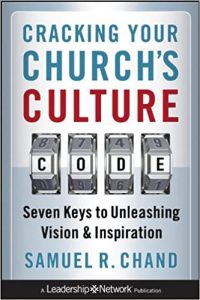 Title: Cracking Your Church’s Culture Code
Title: Cracking Your Church’s Culture Code
Author: Samuel R. Chand
Copyright Date: 2011
Book Notes:
Self-reflection is both planned and spontaneous. A question that I teach people to ask about themselves at regular intervals is, “What is it about me that keeps me from becoming the best me that God intended me to be?” This question invites us to take full responsibility for our growth and direction, and it rivets our purpose to God’s plan for our lives. Location 1665
To galvanize people’s resolve to kill the old and raise up a new culture, every growing organization has to make friends with an odd ally: chaos. Location 1885
The way a leader navigates change may do more to define the organization’s culture than any purpose statement. The path charted through threats and opportunities demonstrates the actual values of the leader, the team, and the organization. The response to chaos, then, is both a reflection of the existing culture and an open door to cultural change. Location 1913
I’ve seen leaders experience chaos in countless ways, but three of those ways stand out as unique challenges: redefining failure, creating a sense of urgency to take advantage of opportunities, and managing conflict. Location 1918
Failure can be the platform to learn life’s greatest lessons so that we can continue to think the unimaginable, dream the impossible, and attempt incredible things for God. Location 1984
Great leaders, though, are often misunderstood, especially when they create chaos when everyone expects a time of tranquility. Location 2007
Organizations naturally drift toward complacency instead of urgency, fear rather than optimism, and blaming others instead of taking responsibility. To overcome this drift, leaders can invite fresh, challenging ideas to stimulate creative thinking, tell stories to capture people’s hearts, and be models of urgency for their team members. Location 2062
When I consult with church leaders about hiring or promoting staff, I suggest they ask four questions:
The Diffusion of Innovations model (popularized by Everett Rogers) helps us understand the terrain of our teams and our churches as we propose change. According to this theory, people adopt one of five roles in their response to change. In my book What’s Shakin’ Your Ladder? I identify these as excited embracers, early embracers, middlers, late embracers, and never embracers. The distribution of these roles in a group forms a bell curve.
Reinvent yourself every three years…so that you can remain relevant and able to make new contributions in a world of constant change. …Reinvention is the key to longevity. —Stephen R. Covey Location 2235
When I meet with pastors and discuss the principle of creating an organizational vehicle to fulfill their vision, I want to find out if their vision is clear and strong, and I want to help them see if their organizational structure and people can take them to reach that vision. Dr. Gerald Brooks (www.growingothers.com) has helped me think through this issue by using a series of test questions.
As I’ve worked with church leaders, I’ve observed them moving through the following phases as they’ve implemented new strategies, especially in changing their cultures:
Your future can be bright if
Developing a healthy culture is the “soft side” of leadership, but strategic planning, the “hard side” of leadership, is also essential. The two complement each other. Location 2401
To change things in an organization, it’s far more important to make adjustments to the informal connections, not the formal structure. Location 2486
William Bridges, a noted expert on change and transition, explains in his most recent book, Managing Transitions: Making the Most of Change, that the reason change agents fail is that they focus on the solution instead of the problem. This may seem counterintuitive to forward-thinking, visionary leaders, but Bridges teaches that people need to be gripped by the need before they will embrace the solution. In fact, he believes that 90 percent of a leader’s efforts should be spent on selling the problem and helping people understand what is not working. He rightly claims that people don’t perceive the need for a solution if they don’t fully grasp the problem. Location 2549
Changing an unhealthy culture to a strong, vibrant one requires both a sledgehammer and a potter’s wheel. We have to be ruthless to attack systems (not people) that block us from achieving our new objectives, but we also need to carefully mold a new culture with gentleness, wisdom, and strength—like a skilled potter making a beautiful vase. Location 2619
Is it possible to transform a culture? Some of us think that it seems almost too good to be true. But yes, it’s not only possible but also the most productive work we can do because it has a dramatic, multiplied impact—on the team, in the church, and throughout the community. Location 2678
Gifted teachers know that asking a great question is often more valuable than an hour of brilliant lecture. Location 2781
Questions for personal reflection:
The conundrum of leadership is this: people want improvement, but they resist change. Location 2860
All change is a critique of the past. If we’re not careful, we can step on the toes of those we’re trying to lead as we destroy the old vehicle and create a new one. Leaders need to understand what’s at stake in the hearts of those who treasure the past. They may not be thrilled to change vehicles! We can’t improve anything without changing it. The conundrum of leadership is this: people want improvement, but they resist change. Our task is helping them learn to embrace change. Location 2862
Note: should you wish to find any quote in its original context, the Kindle “location” is provided after each entry.

Chuck Olson
More Book Notes
Compiled by Chuck Olson
Compiled by Chuck Olson
Compiled by Chuck Olson
Sign Up for Free Resources via Email